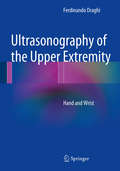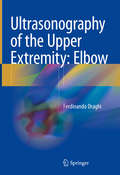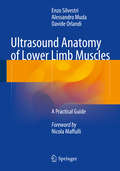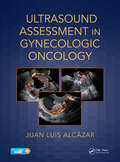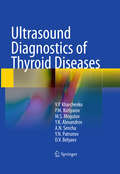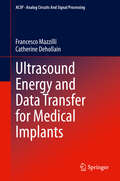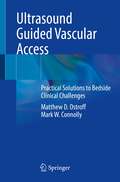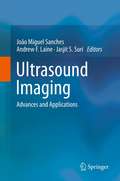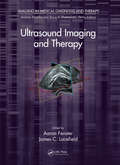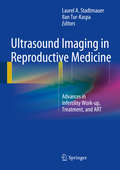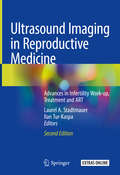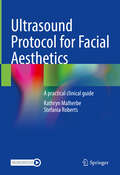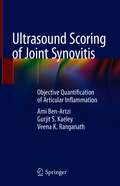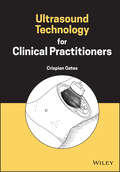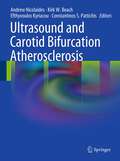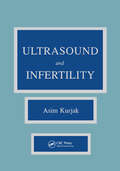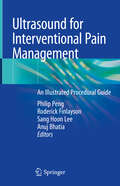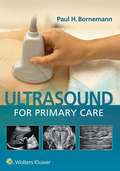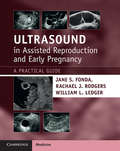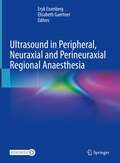- Table View
- List View
Ultrasonography of the Upper Extremity
by Ferdinando DraghiThis practice-oriented book, containing a wealth of high-quality ultrasound images, provides clear, concise, and complete coverage of the normal anatomy of the hand and wrist - tendons, nerves, and vascular structures - as well as the main pathologic conditions encountered in this area. The ultrasound images have been acquired with state of the art scanners and carefully labeled to facilitate recognition of each and every anatomic structure. Helpful comparison is also made with images and findings obtained using other diagnostic techniques, including in particular magnetic resonance imaging. The lucid text is complemented by practical tables summarizing key points for ease of reference. Readers will find Ultrasonography of the Upper Extremity to be a rich source of information on anatomy, examination techniques, and ultrasound appearances of one of the anatomic regions to have benefited the most from the technological revolution that has taken place in the field of ultrasonography during recent years. The book will appeal to both novice and experienced practitioners, including above all radiologists and ultrasound technicians but also rheumatologists and orthopedic surgeons. The author is the Director of the Operative Unit of Ecography at the Institute of Radiology, University Hospital Foundation IRCCS Policlinico San Matteo Pavia (Italy), and is Editor in Chief of The Journal of Ultrasound.
Ultrasonography of the Upper Extremity: Elbow
by Ferdinando DraghiThis book on elbow ultrasonography is a practice-oriented book, offering a wealth of high-quality ultrasound images, and providing clear, concise, and comprehensive coverage of the normal anatomy as well as the main pathologic conditions of the elbow. The ultrasound images have been obtained using state-of-the-art scanners and carefully labeled to facilitate recognition of each condition. The book also provides a helpful comparison of the images and findings obtained using other diagnostic techniques, including magnetic resonance imaging. The text is complemented by practical tables summarizing key points for ease of reference. Ultrasonography of the Upper Extremity: Elbow is a rich source of information on the anatomy, examination techniques and ultrasound appearances of one of the anatomic regions to have benefited most from the technological revolution that has taken place in the field of ultrasonography in recent years. The book appeals to both novice and experienced practitioners, including above all radiologists and ultrasound technicians, as well as rheumatologists and orthopedic surgeons.
Ultrasound Anatomy of Lower Limb Muscles
by Enzo Silvestri Davide Orlandi Alessandro MudaThe book provides a comprehensive description of the basic ultrasound principles, normal anatomy of the lower limb muscles and classification of muscle strain injuries. Ultrasound images are coupled with anatomical schemes explaining probe positioning and scanning technique for the various muscles of the thigh and leg. For each muscle, a brief explanation of normal anatomy is also provided, together with a list of tricks and tips and advice on how to perform the ultrasound scan in clinical practice. This book is an excellent practical teaching guide for beginners and a useful reference for more experienced sonographers.
Ultrasound Anatomy of Lower Limb Muscles: A Practical Guide
by Enzo Silvestri Davide Orlandi Alessandro MudaThe book provides a comprehensive description of the basic ultrasound principles, normal anatomy of the lower limb muscles and classification of muscle strain injuries. Ultrasound images are coupled with anatomical schemes explaining probe positioning and scanning technique for the various muscles of the thigh and leg. For each muscle, a brief explanation of normal anatomy is also provided, together with a list of tricks and tips and advice on how to perform the ultrasound scan in clinical practice. This book is an excellent practical teaching guide for beginners and a useful reference for more experienced sonographers.
Ultrasound Assessment in Gynecologic Oncology
by Juan Luis AlcázarThis innovative guide will help gynecologists or gynecologic surgeons to monitor the staging and progress of oncology treatment. An international expert here shows what office ultrasound can be used to achieve, how it correlates with other clinical findings, and how it can be integrated as necessary with other modalities and with the latest technological advances and developments in the field.
Ultrasound Diagnostics of Thyroid Diseases
by Alexander N. Sencha Yury K. Alexandrov Yury N. Patrunov Denis V. Belyaev Mikhail S. Mogutov Peter M. Kotlyarov Vladimir P. KharchenkoAs the basis for this book, the authors have analyzed more than 100,000 ultrasound examinations performed between 1995 and 2008 in patients with thyroid and parathyroid disease, as well as many thousands of diagnostic and therapeutic ultrasound-guided minimally invasive procedures. The opening chapters include discussion of current ultrasound techniques, pitfalls, and ultrasound examination of the thyroid in children. Detailed attention is then devoted to findings in the normal thyroid and in the presence of diffuse and focal changes. Further chapters focus on such topics as the role of ultrasound after thyroid surgery and ultrasound diagnosis of parathyroid disease, recurrent goiter, and neck masses. Ultrasound-guided minimally invasive techniques, such as fine-needle aspiration biopsy and percutaneous laser ablation, are considered in depth. This up-to-date and richly illustrated book will interest and assist specialists in ultrasound diagnostics, radiologists, endocrinologists, and neck surgeons.
Ultrasound Energy and Data Transfer for Medical Implants (Analog Circuits and Signal Processing)
by Catherine Dehollain Francesco MazzilliThis book presents new systems and circuits for implantable biomedical applications, using a non-conventional way to transmit energy and data via ultrasound. The authors discuses the main constrains (e.g. implant size, battery recharge time, data rate, accuracy of the acoustic models) from the definition of the ultrasound system specification to the in-vitro validation.The system described meets the safety requirements for ultrasound exposure limits in diagnostic ultrasound applications, according to FDA regulations. Readers will see how the novel design of power management architecture will meet the constraints set by FDA regulations for maximum energy exposure in the human body. Coverage also includes the choice of the acoustic transducer, driven by optimum positioning and size of the implanted medical device. Throughout the book, links between physics, electronics and medical aspects are covered to give a complete view of the ultrasound system described.Provides a complete, system-level perspective on the use of ultrasound as energy source for medical implants;Discusses system design concerns regarding wireless power transmission and wireless data communication, particularly for a system in which both are performed on the same channel/frequency;Describes an experimental study on implantable battery powered biomedical systems;Presents a fully-integrated, implantable system and hermetically sealed packaging.
Ultrasound Fundamentals: An Evidence-Based Guide for Medical Practitioners
by Nalini Vadivelu Alan David Kaye Jinlei Li Robert Ming-Der ChowWritten by experts in the field, this concise and evidence-based ultrasound text includes key topics ranging from the head and neck to the upper and lower extremity, covering all the clinically relevant sonoanatomy. This 33-chapter book emphasizes the practical use of ultrasound for the diagnosis and treatment of a multitude of conditions in various specialty areas such as airway management, cardiovascular disease assessment, pulmonary status evaluation, orthopedics, gynecology and pediatrics. The optimal techniques and the step-by-step interpretation of normal and pathologic sonoanatomy are discussed in detail. This text can be used as a starting point for the study of ultrasound guided diagnosis and treatment, a refresher manual for sonoanatomy on major organ systems, or a last-minute guide before a bedside procedure. There is a great breadth of material that is covered in a comprehensive manner, making it a great resource for board review and exam preparation for various medical, surgical and allied specialties. Unique and pragmatic, Ultrasound Fundamentals is a back to basics manual on normal and pathologic sonoanatomy of head and neck, upper and lower extremity, chest, abdomen and other major organ systems
Ultrasound Guided Vascular Access: Practical Solutions to Bedside Clinical Challenges
by Matthew D. Ostroff Mark W. ConnollyThis casebook covers ultrasound guided vascular access with a focus on patient safety. Vascular access is the catalyst between provider and patient. Initially, patients were treated at hospitals for grave illnesses or terrible accidents; however, due to significant strides in medicine, the emerging hospitalized patient is now more commonly treated for chronic illnesses. For these patients, repeated hospital visits slowly deplete their vasculature, creating one of modern medicine’s greatest obstacles: vascular access. This book provides safe solutions to bedside clinical challenges from peripheral to tunneled central lines in the neonatal, pediatric, and adult patient populations.Chapters present unique patient cases, incorporating the latest technology and techniques for safely and methodically meeting vascular access challenges, detailed discussions on therapeutic interventions, and trouble shooting. The book is structured so that each chapter builds on the last, offering peripheral, central, and tunneled catheter solutions through a standardized approach. Finally, each part features a COVID-19 case study including vascular access performed in the prone position. This is an ideal guide for trainees, students, clinicians, and healthcare professionals performing ultrasound guided vascular access on patients.
Ultrasound Imaging
by Jasjit S. Suri Andrew F. Laine João Miguel SanchesDiagnostic and Therapeutic Ultrasound has recently taken an explosive growth for better safer, economic, mobile and high quality healthcare. This technology is very appealing for medical applications because it is non-ionizing, non-invasive and it is available in most of the medical and clinical facilities. Its low cost, when compared with other medical image modalities, makes it one of the preferred tools for medical monitoring, follow-up and diagnosis. Besides the traditional fields of Cardiology and Obstetrics, where it is extensively used for long time, it has became also very useful in the diagnosis of diseases of the prostate, liver and coronaries and carotids atherosclerosis. However, Ultrasound images present poor quality, very low signal to noise ratio and a lot of artifacts. The extraction of useful information from Ultrasound data for diagnosis is a challenge task that makes this medical image modality a very active field of research. The difficulties are being overcome and novel and advanced methods are being proposed for detection, characterization and segmentation of abnormalities in several organs. In fact, Ultrasound application range is vast, covering almost all organs of the human body, including the brain where Tran-cranial Doppler Ultrasound is very important to assess the brain vasculature. This book presents some of the recent advances in Ultrasound imaging technology covering several organs and techniques in a Biomedical Engineering (BME) perspective. The focus of the book is in the algorithms, methodologies and systems developed by multidisciplinary research teams of engineers and physicians for Computer-Aided Diagnosis (CAD) purposes. Cardiovascular and Cancer, the most common life-threatening diseases in western countries, are two of the most important topics focused in the book. However, other advanced issues are also presented such as Intravascular Ultrasound, 3D US and Ultrasound in Computer-Aided Surgery (CAS). Some chapters are direct contributions from medical research groups where Ultrasound has also received great attention in the last decade. By this, new techniques based on Ultrasound were introduced in the clinical practice for diagnosis and therapeutics, mainly in hospital facilities.
Ultrasound Imaging and Therapy (Imaging In Medical Diagnosis And Therapy Ser.)
by Aaron Fenster James C. LacefieldUp-to-Date Details on Using Ultrasound Imaging to Help Diagnose Various DiseasesDue to improvements in image quality and the reduced cost of advanced features, ultrasound imaging is playing a greater role in the diagnosis and image-guided intervention of a wide range of diseases. Ultrasound Imaging and Therapy highlights the latest advances in usin
Ultrasound Imaging in Reproductive Medicine
by Laurel Stadtmauer Ilan Tur-KaspaOver the last 25 years, the advances in ultrasound have paralleled advances in Assisted Reproductive Technology (ART). ART could not even be practiced or considered today without imaging. Ultrasound has become the most important and widely used tool in the diagnosis and treatment of infertility. Ultrasound evaluation is one of the first steps to assess the cause of infertility; the three areas of evaluation are the ovaries, uterus, and fallopian tubes. Ultrasound allows physicians to diagnose ovarian reserve but also pathologies such as polycystic ovarian syndrome, endometriosis, or other ovarian cysts that can impact fertility. The results of this initial exam immediately affect the decisions in the management of the patient's condition. When fertility treatments begin, ultrasound is used in almost any interaction with the patient in order to monitor follicular development and endometrial response; ultrasound guidance is also vital for embryo retrieval and transfer (ET). Ultrasound Imaging in Reproductive Medicine provides a comprehensive survey of the use of ultrasonography in the female pelvis for physicians, nurses, and ultrasonographers actively involved in reproductive medicine and infertility. With a critical evaluation of advantages and disadvantages, the book covers traditional and new technologies, including three-dimensional (3D) ultrasound for ovarian reserve, ovarian monitoring and endometrial cavity assessment, Ultrasound, MRI and CT evaluation of tubal patency, MRI guided ultrasound procedures for treatment of uterine fibroids, imaging techniques of the embryo and embryo transfer, and pulsed color Doppler techniques. 3D ultrasound to assess ovarian and endometrial volume and 3D automated monitoring of follicles are also covered in detail with up to date references.
Ultrasound Imaging in Reproductive Medicine: Advances in Infertility Work-up, Treatment and ART
by Ilan Tur-Kaspa Laurel A. StadtmauerNow in an updated edition, this is the most comprehensive book on modern ultrasound imaging in assisted reproductive technology (ART) and reproductive medicine. Fully revised and expanded, it covers emerging technologies possible with the improvement in ultrasound equipment. 3-D monitoring of ovarian follicles, bidirectional vibrant color and Doppler, and improved 3-D and 4-D imaging of reproductive structures are discussed. MRI-guided ultrasound procedures are covered, and comparisons of 3-D imaging with MRI imaging for uterine anomalies is reviewed with an emphasis on the advantages of 3-D performed in the gynecologist’s office, and as a less expensive modality.The overall approach of the original edition is maintained, starting with ultrasound safety and technique and diagnosis of the ovary, uterus and fallopian tubes (both normal and pathologic), followed by both male and female infertility and ART treatments and procedures. Ultrasound monitoring of follicular development, the endometrium, and as an aid in embryo transfer to maximize IVF success rates are reviewed. Topics new to this edition include updated information on the diagnosis of benign and malignant adnexal masses, 3-D follicle monitoring, and the diagnosis of adenomyosis and endometriosis, including deep inseminated endometriosis. Additionally, the evaluation of endometrial receptivity, the use of contrasts for fallopian tube patency, controversies regarding septate uterus versus arcurate uterus with the use of 3-D ultrasound, and 3-D ultrasound with saline infusion sonogram and early pregnancy ultrasound are all discussed.An excellent resource for reproductive medicine and ART specialists, gynecologists and ultrasonographers alike, Ultrasound Imaging in Reproductive Medicine, Second Edition covers all that clinicians need to know about the role of ultrasound, from the first time a woman comes into the clinic for treatment, including ART, to early pregnancy monitoring. See better, do ART better.
Ultrasound Program Management: A Comprehensive Resource for Administrating Point-of-Care, Emergency, and Clinical Ultrasound
by Vivek S. Tayal Troy R. Foster Rachel B. Liu Petra E. Duran-GehringThis book addresses the diverse challenges clinical ultrasound program leaders face, including choosing equipment, building quality improvement programs, understanding credentialing and privileging, and optimizing reimbursement. While mastering the ultrasound probe may seem straightforward, the real challenge lies in delivering safe, efficient, meaningful, transferable, and reimbursable services in modern medicine. This update to the widely used predecessor expands on the original chapters and introduces new ones that explore nuanced aspects of ultrasound program management. Early chapters focus on leadership in ultrasound programs within departments or institutions. Later chapters delve into specific applications, such as hospitalist services, outpatient medicine, pediatrics, prehospital care, and intensive care units. This edition also highlights emerging technologies and their integration into an ultrasound program. New chapters cover topics such as "Social Media in Ultrasound Management," "Cybersecurity," "Artificial Intelligence in Point-of-Care Ultrasound," and "Practical Operating Solutions for Resource-Limited Settings." This edition of Ultrasound Program Management will be invaluable for ultrasound program and medical academic leaders, and those seeking to build successful clinician-performed ultrasound programs.
Ultrasound Protocol for Facial Aesthetics: A practical clinical guide
by Kathryn Malherbe Stefania RobertsThis book provides a systematic approach to facial ultrasound, using anatomical landmarks and targeting common facial muscles during aesthetic treatment. It also includes the most common clinical indications and complications found during aesthetic therapy. The various muscles have been grouped into the upper, mid and lower face and are also classified as either easy, intermediate or advanced in the level of experience a user requires to discern these muscles on ultrasound. High-frequency ultrasound in the field of radiology has progressed to other fields of medical treatment, most notably within aesthetic medicine in recent years. Facial ultrasound has been limited to the clinical assessment of varying skin conditions, as the diagnosis and treatment have been primarily based on dermatological assessment. Having said that, the recent increase in aesthetic treatment methods has led to a rising number of complications, risks, and poor outcomes. The singular use of surface anatomy and clinical presentation of a patient before fillers are used has proven to be limited in assessing the risks prior to treatment. For this reason, ultrasound of the face has allowed clinicians to develop a keen sense of vascular presence, asymmetry of muscles, and also to help determine the depth for needle-guided injections.
Ultrasound Scoring of Joint Synovitis: Objective Quantification of Articular Inflammation
by Ami Ben-Artzi Gurjit S. Kaeley Veena K. RanganathA common manifestation of many autoimmune diseases is joint inflammation. The degree of inflammation of the joints is often used as a metric of disease activity. Assessing disease activity has diagnostic, therapeutic, and prognostic implications. Inflammation of the joints is often used as a proxy for inflammation in other tissue, and assessing this inflammation has implications for the health of numerous organs in in the body. Currently, physicians use palpation of joints to assess for joint inflammation. This method, while accessible and easy to apply, is lacking in precision. Ultrasound has also been used to assess for joint inflammation for over 20 years, but applying ultrasound technology has proved challenging. There is lack of agreement on optimal joint view, which joints should be examined in which disease, and how inflammation should be graded. Various scanning protocols and grading schemes have been proposed, but each has its strengths and weaknesses. Ultrasound Scoring of Joint Synovitis is based off the work of three authors who tackled the limitations of contemporary inflammation scoring systems, and developed an ultrasound-based inflammation scoring system which can be applied with consistency and reproducibility. In their research, the authors scanned thousands of joints and spent thousands of hours discussing the scans. They produced a scoring system which will allow the user of the atlas to grade joint inflammation in a way that is less subjective and more reproducible than the current systems used. Objective descriptions allow the user to quantify sonographic signs of joint inflammation with an intentional bias for the more clinically relevant features of ultrasound pathology. For students of musculoskeletal ultrasound, the book offers detailed descriptions of the sonographic appearance of every level of joint inflammation. For researchers, the book, and the system laid out in the book, are truly state-of-the-art and will enable better precision in research and clinical care of patients with joint inflammation.
Ultrasound Technology for Clinical Practitioners
by Crispian OatesUltrasound Technology for Clinical Practitioners A hands-on and practical roadmap to ultrasound technology for clinical practitioners who use it every day In Ultrasound Technology for Clinical Practitioners, distinguished medical physicist and vascular ultrasound scientist Crispian Oates delivers an accessible and practical resource written for the everyday clinical user of ultrasound. The book offers complete descriptions of the latest techniques in ultrasound, including ultrafast ultrasound and elastography, providing an up-to-date and relevant resource for educators, students, and practitioners alike. Ultrasound Technology for Clinical Practitioners uses a first-person perspective that walks readers through a relevant and memorable story containing necessary information, simplifying retention and learning. It makes extensive use of bulleted lists, diagrams, and images, and relies on mathematics and equations only where necessary to illustrate the relationship between other factors. Physics examples come from commonly known contexts that readers can relate to their everyday lives, and additional description boxes offer optional, helpful info in some topic areas. Readers will also find: A thorough introduction to the foundational physics of ultrasound, as well as the propagation of the ultrasound pulse through tissue Comprehensive discussions of beam shapes, transducers, imaging techniques, and pulse echo instrumentation In-depth examination of image quality and artefacts and the principles of Doppler and colour Doppler ultrasound Fulsome treatments of measurement taking and safety and quality assurance in ultrasound Perfect for sonographers, echocardiographers, and vascular scientists, Ultrasound Technology for Clinical Practitioners will also earn a place in the libraries of radiologists, cardiologists, emergency medicine specialists, and all other clinical users of ultrasound.
Ultrasound and Carotid Bifurcation Atherosclerosis
by Efthyvoulos Kyriacou Kirk W. Beach Constantinos S. Pattichis Andrew NicolaidesUltrasound and Carotid Bifurcation Atherosclerosis provides a comprehensive overview of the most recent advancements in instrumentation, imaging techniques including the use of contrast enhancement agents, plaque image analysis and its automation, elastography and plaque motion analysis; also, the use of ultrasonic and other biomarkers in the detection of the high risk cardiovascular individual. Finally, it deals with the application of IVUS, TCD and carotid plaque characterization in clinical practice and in stroke risk stratification. Ultrasound and Carotid Bifurcation Atherosclerosis is intended for all those working in the field of atherosclerosis, ultrasound imaging and cardiovascular risk, including the clinician, the vascular ultrasonographer, the epidemiologist, the molecular biologist, the biomedical engineer and the informatics scientist. Furthermore, this book bridges the gap between the researcher and the clinician, who is keen to incorporate the latest results of research to his daily practice.
Ultrasound and Infertility
by Asim KurjakA comprehensive survey of the use of ultrasound in management of infertile patients is presented in this publication. Particular atten-tion is given to recently developed techniques such as assessment of endometrial changes, ovarian blood flow measurements, and per-cutaneous oocyte retrieval for in vitro fertilization. The very re-cent technique of transvaginal sonography is presented and richly illus-trated with original results obtained in biopsy-guided oocyte re-trieval, and in the precise delineation of follicle size and number for infertility treatment. Guidance in the interpretation of ultrasonic findings, which include potential limitations and pitfalls, is provided in each chapter. Researchers and practitioners interested in the management of infertile patients will find this volume indispensable.
Ultrasound for Interventional Pain Management: An Illustrated Procedural Guide
by Philip Peng Roderick Finlayson Sang Hoon Lee Anuj BhatiaDue to a wide-spread developing interest in ultrasound-guided pain intervention by clinicians, the demand for a practical reference material on this topic has grown simultaneously. This book thoroughly satisfies the need for such a reference, as it contains text written by experts in the field and a multitude of unique, educational illustrations. Spinal pain, the musculoskeletal system, and peripheral structures function as the fundamental items of discussion across three divided sections. In order to augment the reader’s learning experience, the high-quality images found within each chapter provide step-by-step guidance on the various ultrasound scanning procedural processes. Additionally, tips and pearls for scan and injection supplement each chapter conclusion. Ultrasound for Interventional Pain Management: An Illustrated Procedural Guide is a pragmatic, indispensable resource that helps interested clinical practitioners enhance their visual memory and overall understanding of this method.
Ultrasound for Primary Care (M - Medicine Ser.)
by Paul BornemannMaster high-yield point-of-care ultrasound applications that are targeted specifically to answer questions that arise commonly in the outpatient clinic! Written for primary care providers in Family Medicine, Pediatrics and Internal Medicine, Ultrasound for Primary Care is a practical, easy-to-read guide. Learn to incorporate ultrasound to augment your physical exam for evaluation of thyroid nodules, enlarged lymph nodes, pericardial effusion, chronic kidney disease, and a host of musculoskeletal issues, and much more. Additionally, included are chapters on ultrasound for guidance of procedures including joint injections, lumbar puncture and needle biopsy, to name a few. Well-illustrated and highly templated, this unique title helps you expand the scope of your practice and provide more effective patient care.
Ultrasound in Assisted Reproduction and Early Pregnancy
by Arianna D’Angelo and Nazar N. AmsoThis text offers a succinct overview of the essential clinical applications of ultrasound in infertility management. It will be of benefit to established practitioners in reproductive medicine, as it details the aspects of quality, safety, training, and certification that help improve standards of practice. Those in training or with a special interest in fertility issues will also find it essential reading. Print versions of this book also include access to the eBook version with links to procedural videos.
Ultrasound in Assisted Reproduction and Early Pregnancy: A Practical Guide
by Jane S. Fonda Rachael J. Rodgers William L. LedgerUltrasonography is a crucial tool in successful assisted reproduction but requires a steady hand and can often be difficult for unconfident clinicians. A comprehensive ultrasound imaging reference, this is an essential guide for trainee clinicians, ultrasonographers, and nurses working in the field of assisted reproductive technology. Providing the reader with an overview of the process and a foundation to direct their ultrasound assessment of each patient, it contains highly practical tips and tricks for obtaining the best images. Heavily illustrated with example images, the role of ultrasound in fertility treatment is explained, as well as how to identify the uterus and ovaries, measure the endometrium, count follicles and recognize pathology. The role of ultrasound in assisted reproduction is covered, including transvaginal oocyte collection, embryo transfer, early pregnancy, miscarriage and ectopic pregnancy. This is an indispensable reference for clinicians new to ultrasound in assisted reproduction.
Ultrasound in Gynecology
by Mala SibalThis atlas and guide book is focused on gynecological ultrasound, an area that has remained in the shadow of obstetric ultrasound & fetal medicine. Gynecological ultrasound has seen rapid advances owing to expanding research and improved ultrasound equipment. This book leverages these advances and provides abundant illustrations and practice points of classical and new ultrasound features. It serves as a guide for radiologists, gynecologists and sonologists for the accurate diagnosis of gynecological pathologies. The chapters of this book also serve as a comprehensive resource for various topics with hundreds of images and figures, including basic gray scale images, Doppler studies and three dimensional ultrasound illustrations. In addition, standard terms for the evaluation and reporting of gynecological pathologies are discussed. Emergencies like ovarian torsion, complex adnexal cyst are also covered.
Ultrasound in Peripheral, Neuraxial and Perineuraxial Regional Anaesthesia
by Eryk Eisenberg Elisabeth GaertnerThis comprehensive, highly didactic book on ultrasound-guided regional anesthesia (peripheral, neuraxial and perineuraxial nerve blocks) presents meticulously labelled images, diagrams and picture-in-picture samples and includes high-quality, vignetted illustrations that are consistent in style. The ultrasound images are outstanding and carefully selected to demonstrate the most clinically relevant situations. Importantly, they have a real-world appearance, including actual needle paths and desired disposition of injectate during nerve block procedures; most are from the original database of Dr. Eisenberg. All the supplementary material is authoritative and presented as an artful balance of years of clinical experience and a summary of the peer reviewed literature.Ultrasound in Peripheral, Neuraxial and Perineuraxial Regional Anaesthesia, accompanied by richly illustrated material and videos of state-of-the-art techniques, is of interest to anyone interested in learning, furthering their existing knowledge of, or teaching ultrasound-guided regional anesthesia.
